Real Estate Finance Analysis: Holt Lunsford Commercial Case Study
VerifiedAdded on 2023/01/17
|10
|1878
|97
Report
AI Summary
This report presents a comprehensive analysis of a real estate finance case study involving Holt Lunsford Commercial, a Dallas-based commercial services firm. The core of the report revolves around evaluating two primary options for the company: leasing a property versus purchasing one. The analysis considers various financial factors, including sales, cost of goods sold, business expenses, and tax implications. The report explores the advantages and disadvantages of each option, taking into account market conditions, operational flexibility, initial investment costs, and potential tax benefits. The leasing option is assessed based on square footage, occupancy costs, and the potential for tax shields. The buying option considers the purchase price, operating expenses, interest expenses, and potential salvage value. The report also includes loan amortization and capital gain tax calculations. Ultimately, the report concludes that the leasing option is the more viable and flexible choice for the company's expansion, based on the provided financial analysis and strategic considerations.

Running head: REAL ESTATE FINANCE
Real Estate
Name of the Student:
Name of the University:
Author’s Note:
Real Estate
Name of the Student:
Name of the University:
Author’s Note:
Paraphrase This Document
Need a fresh take? Get an instant paraphrase of this document with our AI Paraphraser
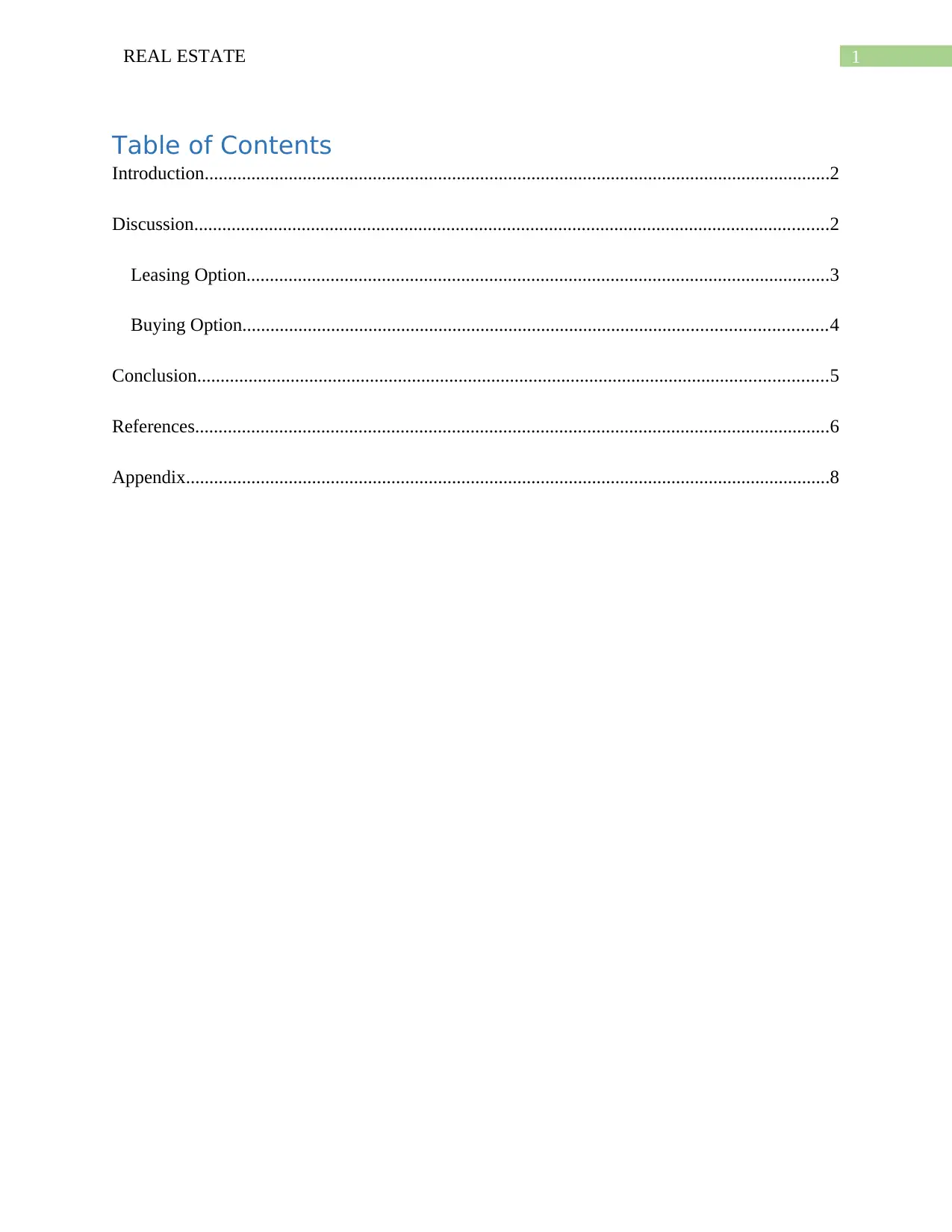
1REAL ESTATE
Table of Contents
Introduction......................................................................................................................................2
Discussion........................................................................................................................................2
Leasing Option.............................................................................................................................3
Buying Option.............................................................................................................................4
Conclusion.......................................................................................................................................5
References........................................................................................................................................6
Appendix..........................................................................................................................................8
Table of Contents
Introduction......................................................................................................................................2
Discussion........................................................................................................................................2
Leasing Option.............................................................................................................................3
Buying Option.............................................................................................................................4
Conclusion.......................................................................................................................................5
References........................................................................................................................................6
Appendix..........................................................................................................................................8
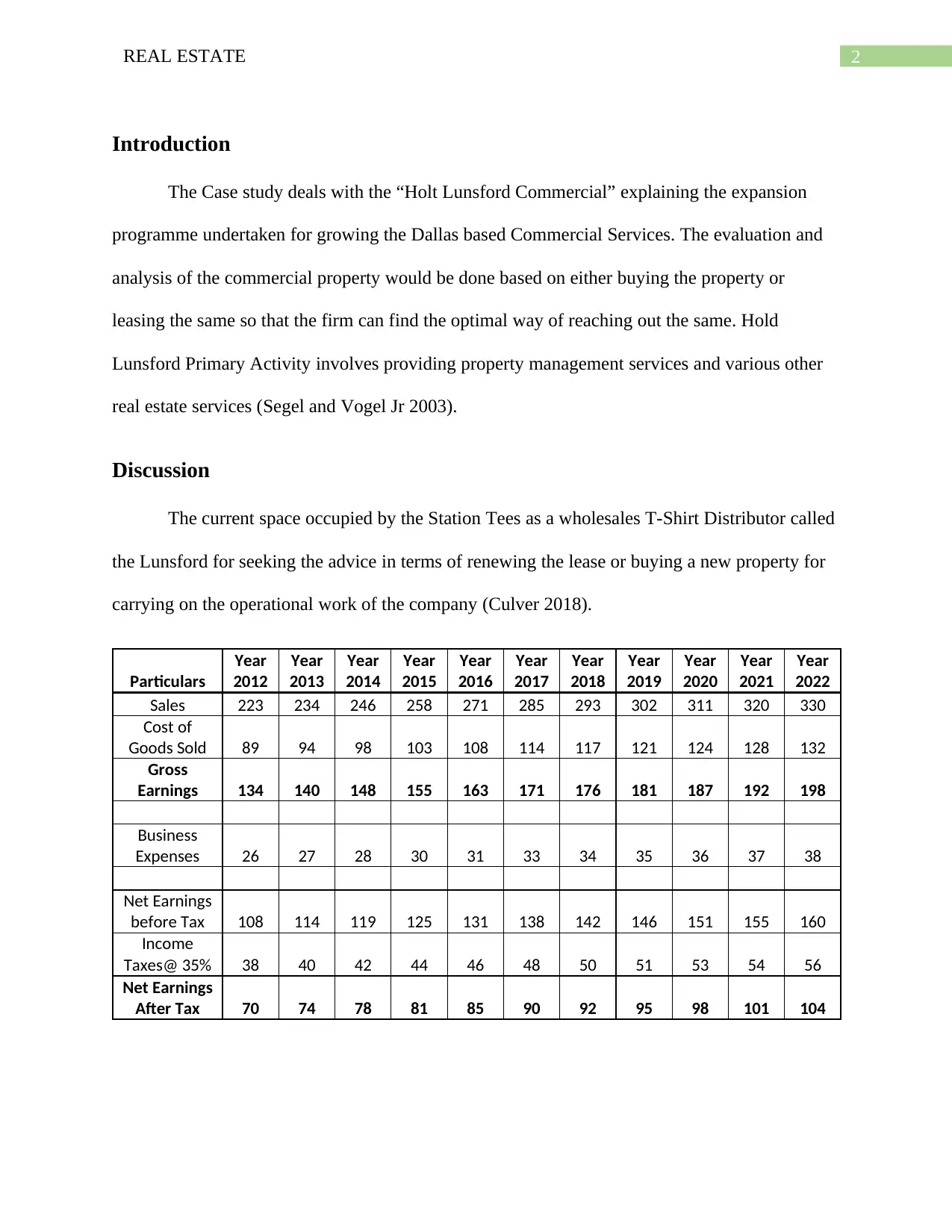
2REAL ESTATE
Introduction
The Case study deals with the “Holt Lunsford Commercial” explaining the expansion
programme undertaken for growing the Dallas based Commercial Services. The evaluation and
analysis of the commercial property would be done based on either buying the property or
leasing the same so that the firm can find the optimal way of reaching out the same. Hold
Lunsford Primary Activity involves providing property management services and various other
real estate services (Segel and Vogel Jr 2003).
Discussion
The current space occupied by the Station Tees as a wholesales T-Shirt Distributor called
the Lunsford for seeking the advice in terms of renewing the lease or buying a new property for
carrying on the operational work of the company (Culver 2018).
Particulars
Year
2012
Year
2013
Year
2014
Year
2015
Year
2016
Year
2017
Year
2018
Year
2019
Year
2020
Year
2021
Year
2022
Sales 223 234 246 258 271 285 293 302 311 320 330
Cost of
Goods Sold 89 94 98 103 108 114 117 121 124 128 132
Gross
Earnings 134 140 148 155 163 171 176 181 187 192 198
Business
Expenses 26 27 28 30 31 33 34 35 36 37 38
Net Earnings
before Tax 108 114 119 125 131 138 142 146 151 155 160
Income
Taxes@ 35% 38 40 42 44 46 48 50 51 53 54 56
Net Earnings
After Tax 70 74 78 81 85 90 92 95 98 101 104
Introduction
The Case study deals with the “Holt Lunsford Commercial” explaining the expansion
programme undertaken for growing the Dallas based Commercial Services. The evaluation and
analysis of the commercial property would be done based on either buying the property or
leasing the same so that the firm can find the optimal way of reaching out the same. Hold
Lunsford Primary Activity involves providing property management services and various other
real estate services (Segel and Vogel Jr 2003).
Discussion
The current space occupied by the Station Tees as a wholesales T-Shirt Distributor called
the Lunsford for seeking the advice in terms of renewing the lease or buying a new property for
carrying on the operational work of the company (Culver 2018).
Particulars
Year
2012
Year
2013
Year
2014
Year
2015
Year
2016
Year
2017
Year
2018
Year
2019
Year
2020
Year
2021
Year
2022
Sales 223 234 246 258 271 285 293 302 311 320 330
Cost of
Goods Sold 89 94 98 103 108 114 117 121 124 128 132
Gross
Earnings 134 140 148 155 163 171 176 181 187 192 198
Business
Expenses 26 27 28 30 31 33 34 35 36 37 38
Net Earnings
before Tax 108 114 119 125 131 138 142 146 151 155 160
Income
Taxes@ 35% 38 40 42 44 46 48 50 51 53 54 56
Net Earnings
After Tax 70 74 78 81 85 90 92 95 98 101 104
⊘ This is a preview!⊘
Do you want full access?
Subscribe today to unlock all pages.

Trusted by 1+ million students worldwide
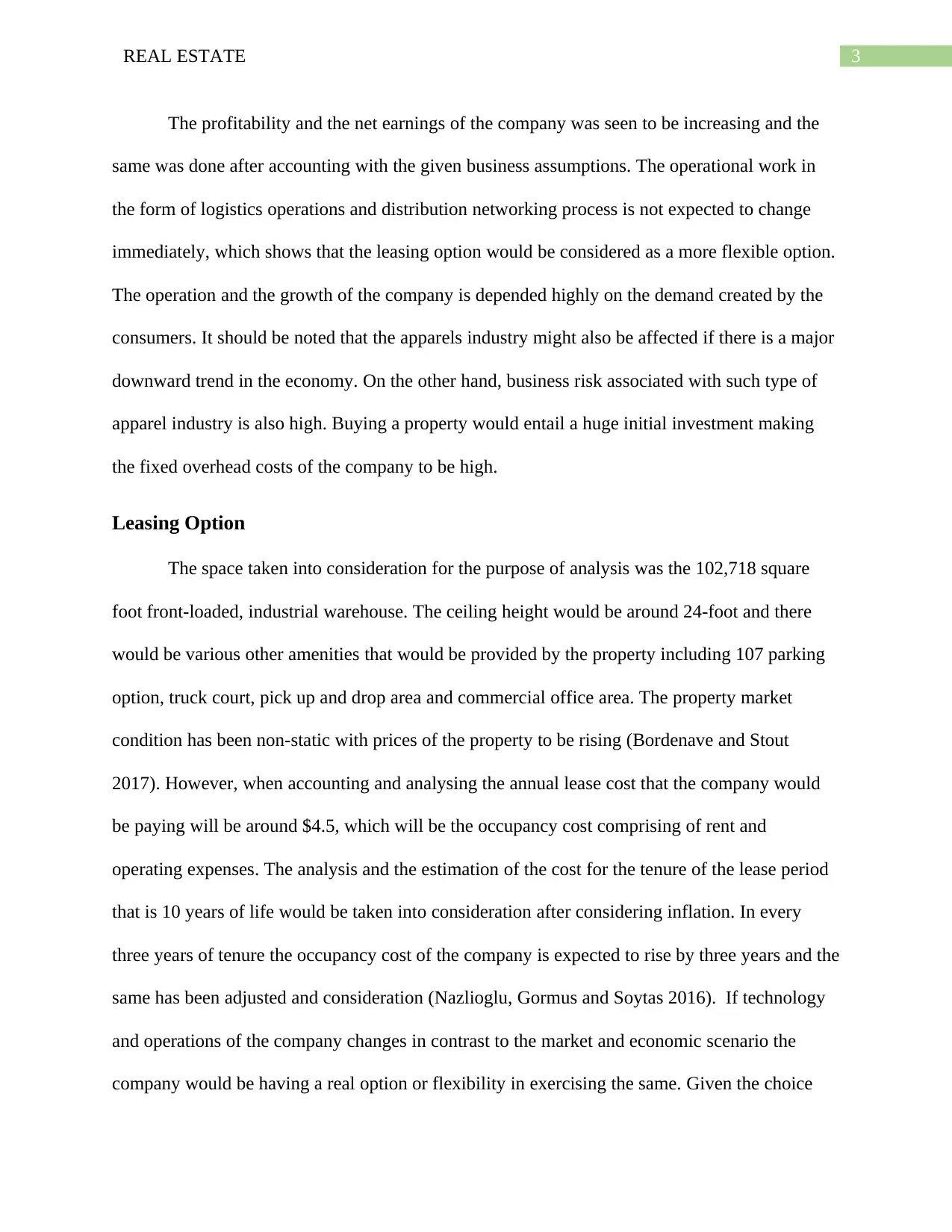
3REAL ESTATE
The profitability and the net earnings of the company was seen to be increasing and the
same was done after accounting with the given business assumptions. The operational work in
the form of logistics operations and distribution networking process is not expected to change
immediately, which shows that the leasing option would be considered as a more flexible option.
The operation and the growth of the company is depended highly on the demand created by the
consumers. It should be noted that the apparels industry might also be affected if there is a major
downward trend in the economy. On the other hand, business risk associated with such type of
apparel industry is also high. Buying a property would entail a huge initial investment making
the fixed overhead costs of the company to be high.
Leasing Option
The space taken into consideration for the purpose of analysis was the 102,718 square
foot front-loaded, industrial warehouse. The ceiling height would be around 24-foot and there
would be various other amenities that would be provided by the property including 107 parking
option, truck court, pick up and drop area and commercial office area. The property market
condition has been non-static with prices of the property to be rising (Bordenave and Stout
2017). However, when accounting and analysing the annual lease cost that the company would
be paying will be around $4.5, which will be the occupancy cost comprising of rent and
operating expenses. The analysis and the estimation of the cost for the tenure of the lease period
that is 10 years of life would be taken into consideration after considering inflation. In every
three years of tenure the occupancy cost of the company is expected to rise by three years and the
same has been adjusted and consideration (Nazlioglu, Gormus and Soytas 2016). If technology
and operations of the company changes in contrast to the market and economic scenario the
company would be having a real option or flexibility in exercising the same. Given the choice
The profitability and the net earnings of the company was seen to be increasing and the
same was done after accounting with the given business assumptions. The operational work in
the form of logistics operations and distribution networking process is not expected to change
immediately, which shows that the leasing option would be considered as a more flexible option.
The operation and the growth of the company is depended highly on the demand created by the
consumers. It should be noted that the apparels industry might also be affected if there is a major
downward trend in the economy. On the other hand, business risk associated with such type of
apparel industry is also high. Buying a property would entail a huge initial investment making
the fixed overhead costs of the company to be high.
Leasing Option
The space taken into consideration for the purpose of analysis was the 102,718 square
foot front-loaded, industrial warehouse. The ceiling height would be around 24-foot and there
would be various other amenities that would be provided by the property including 107 parking
option, truck court, pick up and drop area and commercial office area. The property market
condition has been non-static with prices of the property to be rising (Bordenave and Stout
2017). However, when accounting and analysing the annual lease cost that the company would
be paying will be around $4.5, which will be the occupancy cost comprising of rent and
operating expenses. The analysis and the estimation of the cost for the tenure of the lease period
that is 10 years of life would be taken into consideration after considering inflation. In every
three years of tenure the occupancy cost of the company is expected to rise by three years and the
same has been adjusted and consideration (Nazlioglu, Gormus and Soytas 2016). If technology
and operations of the company changes in contrast to the market and economic scenario the
company would be having a real option or flexibility in exercising the same. Given the choice
Paraphrase This Document
Need a fresh take? Get an instant paraphrase of this document with our AI Paraphraser
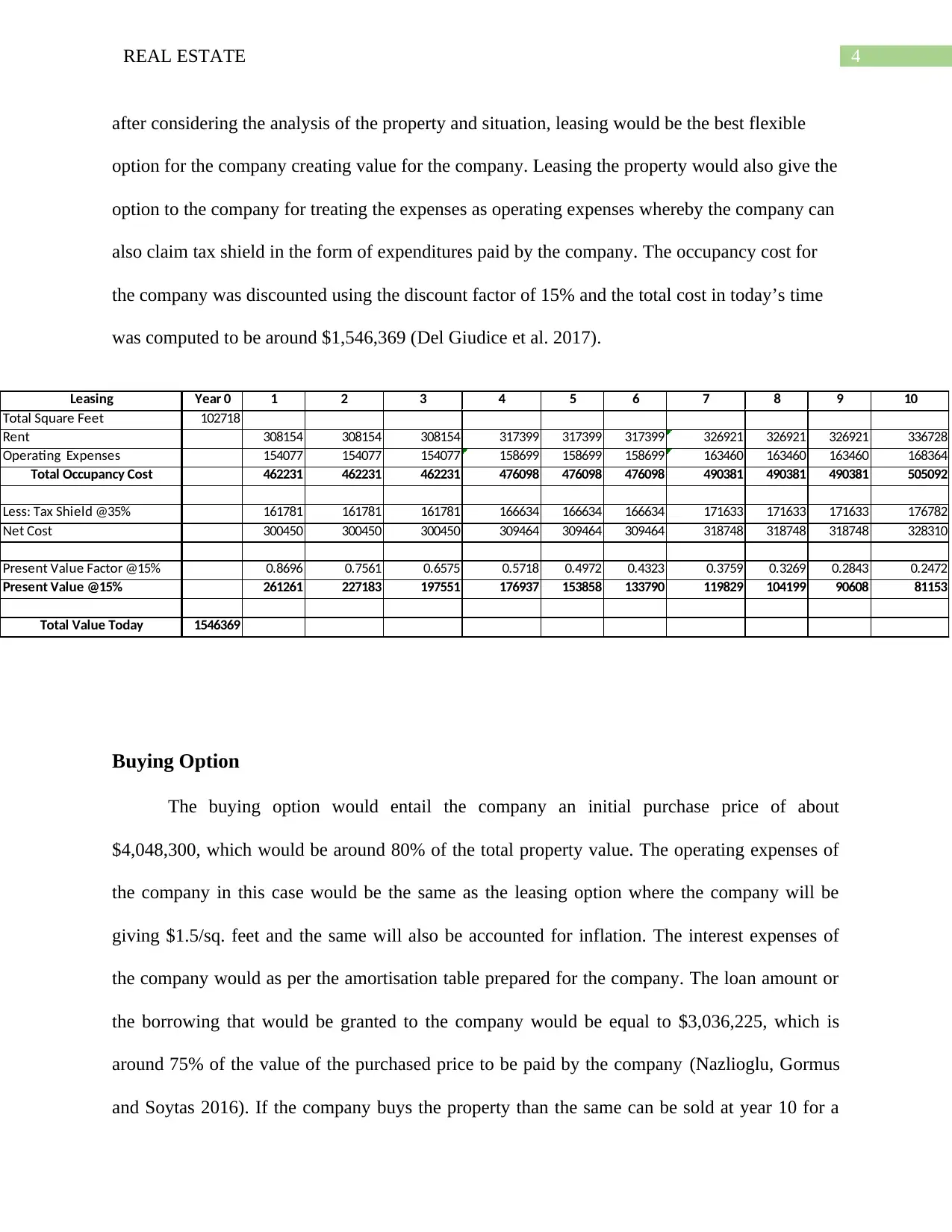
4REAL ESTATE
after considering the analysis of the property and situation, leasing would be the best flexible
option for the company creating value for the company. Leasing the property would also give the
option to the company for treating the expenses as operating expenses whereby the company can
also claim tax shield in the form of expenditures paid by the company. The occupancy cost for
the company was discounted using the discount factor of 15% and the total cost in today’s time
was computed to be around $1,546,369 (Del Giudice et al. 2017).
Buying Option
The buying option would entail the company an initial purchase price of about
$4,048,300, which would be around 80% of the total property value. The operating expenses of
the company in this case would be the same as the leasing option where the company will be
giving $1.5/sq. feet and the same will also be accounted for inflation. The interest expenses of
the company would as per the amortisation table prepared for the company. The loan amount or
the borrowing that would be granted to the company would be equal to $3,036,225, which is
around 75% of the value of the purchased price to be paid by the company (Nazlioglu, Gormus
and Soytas 2016). If the company buys the property than the same can be sold at year 10 for a
Leasing Year 0 1 2 3 4 5 6 7 8 9 10
Total Square Feet 102718
Rent 308154 308154 308154 317399 317399 317399 326921 326921 326921 336728
Operating Expenses 154077 154077 154077 158699 158699 158699 163460 163460 163460 168364
Total Occupancy Cost 462231 462231 462231 476098 476098 476098 490381 490381 490381 505092
Less: Tax Shield @35% 161781 161781 161781 166634 166634 166634 171633 171633 171633 176782
Net Cost 300450 300450 300450 309464 309464 309464 318748 318748 318748 328310
Present Value Factor @15% 0.8696 0.7561 0.6575 0.5718 0.4972 0.4323 0.3759 0.3269 0.2843 0.2472
Present Value @15% 261261 227183 197551 176937 153858 133790 119829 104199 90608 81153
Total Value Today 1546369
after considering the analysis of the property and situation, leasing would be the best flexible
option for the company creating value for the company. Leasing the property would also give the
option to the company for treating the expenses as operating expenses whereby the company can
also claim tax shield in the form of expenditures paid by the company. The occupancy cost for
the company was discounted using the discount factor of 15% and the total cost in today’s time
was computed to be around $1,546,369 (Del Giudice et al. 2017).
Buying Option
The buying option would entail the company an initial purchase price of about
$4,048,300, which would be around 80% of the total property value. The operating expenses of
the company in this case would be the same as the leasing option where the company will be
giving $1.5/sq. feet and the same will also be accounted for inflation. The interest expenses of
the company would as per the amortisation table prepared for the company. The loan amount or
the borrowing that would be granted to the company would be equal to $3,036,225, which is
around 75% of the value of the purchased price to be paid by the company (Nazlioglu, Gormus
and Soytas 2016). If the company buys the property than the same can be sold at year 10 for a
Leasing Year 0 1 2 3 4 5 6 7 8 9 10
Total Square Feet 102718
Rent 308154 308154 308154 317399 317399 317399 326921 326921 326921 336728
Operating Expenses 154077 154077 154077 158699 158699 158699 163460 163460 163460 168364
Total Occupancy Cost 462231 462231 462231 476098 476098 476098 490381 490381 490381 505092
Less: Tax Shield @35% 161781 161781 161781 166634 166634 166634 171633 171633 171633 176782
Net Cost 300450 300450 300450 309464 309464 309464 318748 318748 318748 328310
Present Value Factor @15% 0.8696 0.7561 0.6575 0.5718 0.4972 0.4323 0.3759 0.3269 0.2843 0.2472
Present Value @15% 261261 227183 197551 176937 153858 133790 119829 104199 90608 81153
Total Value Today 1546369
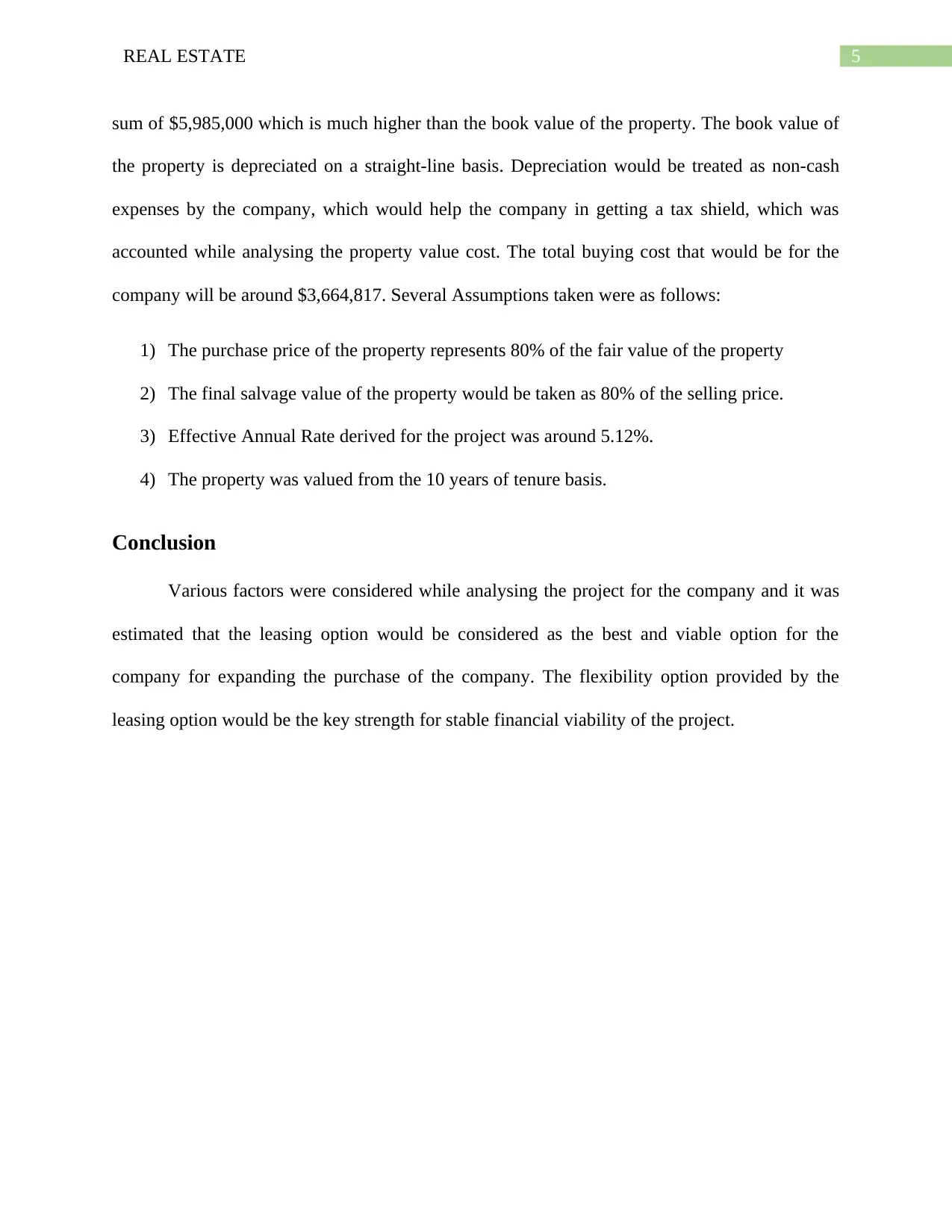
5REAL ESTATE
sum of $5,985,000 which is much higher than the book value of the property. The book value of
the property is depreciated on a straight-line basis. Depreciation would be treated as non-cash
expenses by the company, which would help the company in getting a tax shield, which was
accounted while analysing the property value cost. The total buying cost that would be for the
company will be around $3,664,817. Several Assumptions taken were as follows:
1) The purchase price of the property represents 80% of the fair value of the property
2) The final salvage value of the property would be taken as 80% of the selling price.
3) Effective Annual Rate derived for the project was around 5.12%.
4) The property was valued from the 10 years of tenure basis.
Conclusion
Various factors were considered while analysing the project for the company and it was
estimated that the leasing option would be considered as the best and viable option for the
company for expanding the purchase of the company. The flexibility option provided by the
leasing option would be the key strength for stable financial viability of the project.
sum of $5,985,000 which is much higher than the book value of the property. The book value of
the property is depreciated on a straight-line basis. Depreciation would be treated as non-cash
expenses by the company, which would help the company in getting a tax shield, which was
accounted while analysing the property value cost. The total buying cost that would be for the
company will be around $3,664,817. Several Assumptions taken were as follows:
1) The purchase price of the property represents 80% of the fair value of the property
2) The final salvage value of the property would be taken as 80% of the selling price.
3) Effective Annual Rate derived for the project was around 5.12%.
4) The property was valued from the 10 years of tenure basis.
Conclusion
Various factors were considered while analysing the project for the company and it was
estimated that the leasing option would be considered as the best and viable option for the
company for expanding the purchase of the company. The flexibility option provided by the
leasing option would be the key strength for stable financial viability of the project.
⊘ This is a preview!⊘
Do you want full access?
Subscribe today to unlock all pages.

Trusted by 1+ million students worldwide
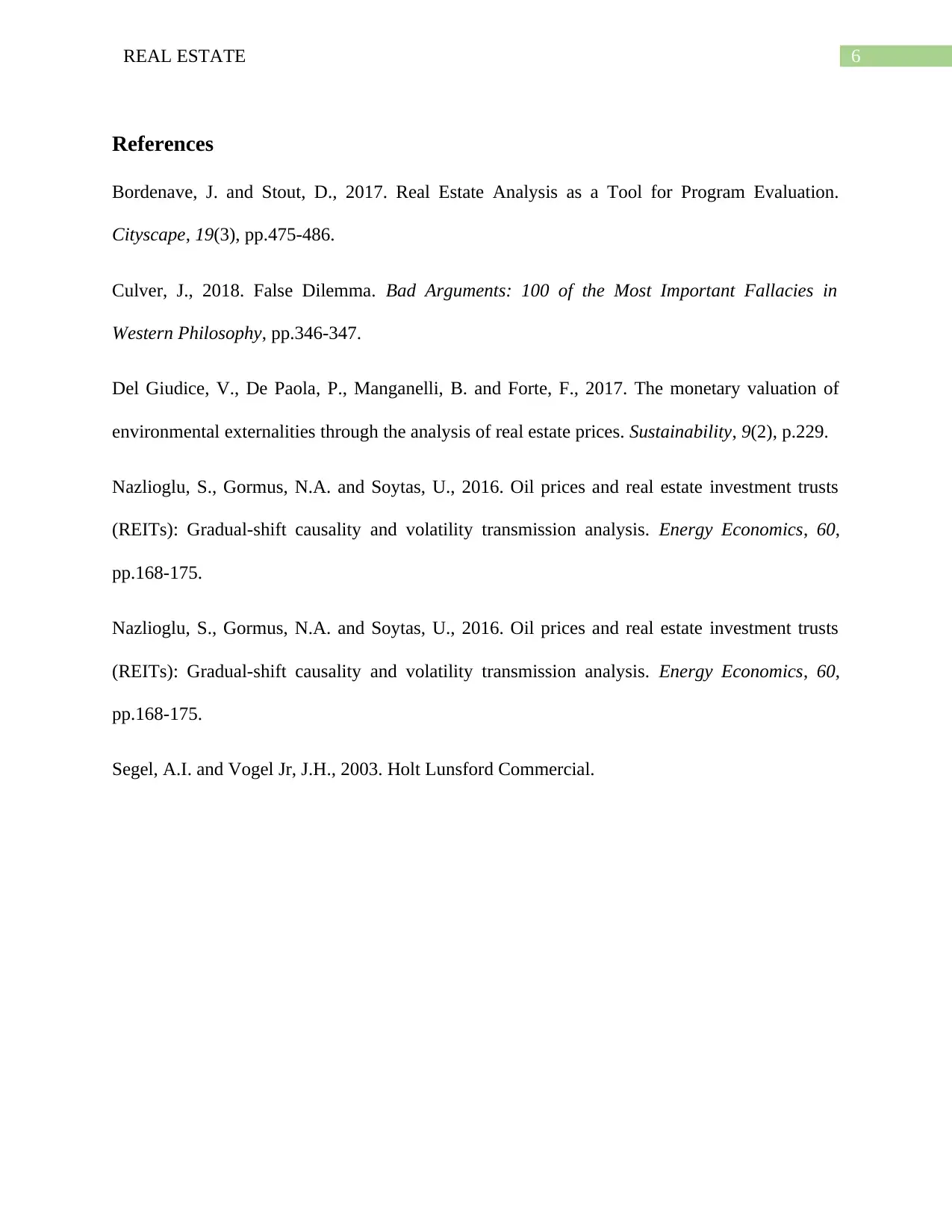
6REAL ESTATE
References
Bordenave, J. and Stout, D., 2017. Real Estate Analysis as a Tool for Program Evaluation.
Cityscape, 19(3), pp.475-486.
Culver, J., 2018. False Dilemma. Bad Arguments: 100 of the Most Important Fallacies in
Western Philosophy, pp.346-347.
Del Giudice, V., De Paola, P., Manganelli, B. and Forte, F., 2017. The monetary valuation of
environmental externalities through the analysis of real estate prices. Sustainability, 9(2), p.229.
Nazlioglu, S., Gormus, N.A. and Soytas, U., 2016. Oil prices and real estate investment trusts
(REITs): Gradual-shift causality and volatility transmission analysis. Energy Economics, 60,
pp.168-175.
Nazlioglu, S., Gormus, N.A. and Soytas, U., 2016. Oil prices and real estate investment trusts
(REITs): Gradual-shift causality and volatility transmission analysis. Energy Economics, 60,
pp.168-175.
Segel, A.I. and Vogel Jr, J.H., 2003. Holt Lunsford Commercial.
References
Bordenave, J. and Stout, D., 2017. Real Estate Analysis as a Tool for Program Evaluation.
Cityscape, 19(3), pp.475-486.
Culver, J., 2018. False Dilemma. Bad Arguments: 100 of the Most Important Fallacies in
Western Philosophy, pp.346-347.
Del Giudice, V., De Paola, P., Manganelli, B. and Forte, F., 2017. The monetary valuation of
environmental externalities through the analysis of real estate prices. Sustainability, 9(2), p.229.
Nazlioglu, S., Gormus, N.A. and Soytas, U., 2016. Oil prices and real estate investment trusts
(REITs): Gradual-shift causality and volatility transmission analysis. Energy Economics, 60,
pp.168-175.
Nazlioglu, S., Gormus, N.A. and Soytas, U., 2016. Oil prices and real estate investment trusts
(REITs): Gradual-shift causality and volatility transmission analysis. Energy Economics, 60,
pp.168-175.
Segel, A.I. and Vogel Jr, J.H., 2003. Holt Lunsford Commercial.
Paraphrase This Document
Need a fresh take? Get an instant paraphrase of this document with our AI Paraphraser

7REAL ESTATE
Appendix
1) Loan Amortisation Table:
Year Opening Amount Interest Principal Repayment Yearly Payment Closing Balance
1 3,036,225 155,352 62,601 217,952.3 2,973,624
2 2,973,624 152,149 65,804 217,952.3 2,907,821
3 2,907,821 148,782 69,170 217,952.0 2,838,651
4 2,838,651 145,243 72,709 217,952.0 2,765,941
5 2,765,941 141,522 76,430 217,952.0 2,689,512
6 2,689,512 137,612 80,340 217,952.0 2,609,172
7 2,609,172 133,501 84,451 217,952.0 2,524,721
8 2,524,721 129,180 88,772 217,952.0 2,435,949
9 2,435,949 124,638 93,314 217,952.0 2,342,635
10 2,342,635 119,863 98,089 217,952.0 2,244,546
11 2,244,546 114,845 103,107 217,952.0 2,141,439
12 2,141,439 109,569 108,383 217,952.0 2,033,056
13 2,033,056 104,024 113,928 217,952.0 1,919,127
14 1,919,127 98,194 119,758 217,952.0 1,799,370
15 1,799,370 92,067 125,885 217,952.0 1,673,484
16 1,673,484 85,626 132,326 217,952.0 1,541,158
17 1,541,158 78,855 139,097 217,952.0 1,402,061
18 1,402,061 71,738 146,214 217,952.0 1,255,847
19 1,255,847 64,257 153,695 217,952.0 1,102,152
20 1,102,152 56,393 161,559 217,952.0 940,593
21 940,593 48,126 169,826 217,952.0 770,767
22 770,767 39,437 178,515 217,952.0 592,252
23 592,252 30,303 187,649 217,952.0 404,603
24 404,603 20,702 197,250 217,952.0 207,353
25 207,353 10,609 207,353 217,952.0 -
Loan Ammortisation Table
Particulars Year 0 Year 1 Year 2 Year 3 Year 4 Year 5 Year 6 Year 7 Year 8 Year 9 Year 10
Initial Outflow (Purchase Consideration) -4048300
Operating Expenses 154077 154077 154077 158699 158699 158699 163460 163460 163460 168364
Interest Expenses 155352 152149 148782 145243 141522 137612 133501 129180 124638 119863
Total Expenses -309429 -306226 -302859 -303942 -300222 -296311 -296961 -292640 -288098 -288228
Tax Shield (Tax Rate @ 35%) 108300 107179 106001 106380 105078 103709 103936 102424 100834 100880
Cash Flows -201129 -199047 -196858 -197562 -195144 -192602 -193025 -190216 -187264 -187348
Salvage Value (After Accounting C.G Tax) 4788000
Net Cash Flows -4048300 -201129 -199047 -196858 -197562 -195144 -192602 -193025 -190216 -187264 4600652
Present Value Factor @15% 1.00 0.87 0.76 0.66 0.57 0.50 0.43 0.38 0.33 0.28 0.25
Discounted Cash Flows -4048300 -174895 -150508 -129437 -112957 -97021 -83267 -72565 -62182 -53232 1137211
Total Cost -3847154
Property Valuation (Buy Consideration)
Appendix
1) Loan Amortisation Table:
Year Opening Amount Interest Principal Repayment Yearly Payment Closing Balance
1 3,036,225 155,352 62,601 217,952.3 2,973,624
2 2,973,624 152,149 65,804 217,952.3 2,907,821
3 2,907,821 148,782 69,170 217,952.0 2,838,651
4 2,838,651 145,243 72,709 217,952.0 2,765,941
5 2,765,941 141,522 76,430 217,952.0 2,689,512
6 2,689,512 137,612 80,340 217,952.0 2,609,172
7 2,609,172 133,501 84,451 217,952.0 2,524,721
8 2,524,721 129,180 88,772 217,952.0 2,435,949
9 2,435,949 124,638 93,314 217,952.0 2,342,635
10 2,342,635 119,863 98,089 217,952.0 2,244,546
11 2,244,546 114,845 103,107 217,952.0 2,141,439
12 2,141,439 109,569 108,383 217,952.0 2,033,056
13 2,033,056 104,024 113,928 217,952.0 1,919,127
14 1,919,127 98,194 119,758 217,952.0 1,799,370
15 1,799,370 92,067 125,885 217,952.0 1,673,484
16 1,673,484 85,626 132,326 217,952.0 1,541,158
17 1,541,158 78,855 139,097 217,952.0 1,402,061
18 1,402,061 71,738 146,214 217,952.0 1,255,847
19 1,255,847 64,257 153,695 217,952.0 1,102,152
20 1,102,152 56,393 161,559 217,952.0 940,593
21 940,593 48,126 169,826 217,952.0 770,767
22 770,767 39,437 178,515 217,952.0 592,252
23 592,252 30,303 187,649 217,952.0 404,603
24 404,603 20,702 197,250 217,952.0 207,353
25 207,353 10,609 207,353 217,952.0 -
Loan Ammortisation Table
Particulars Year 0 Year 1 Year 2 Year 3 Year 4 Year 5 Year 6 Year 7 Year 8 Year 9 Year 10
Initial Outflow (Purchase Consideration) -4048300
Operating Expenses 154077 154077 154077 158699 158699 158699 163460 163460 163460 168364
Interest Expenses 155352 152149 148782 145243 141522 137612 133501 129180 124638 119863
Total Expenses -309429 -306226 -302859 -303942 -300222 -296311 -296961 -292640 -288098 -288228
Tax Shield (Tax Rate @ 35%) 108300 107179 106001 106380 105078 103709 103936 102424 100834 100880
Cash Flows -201129 -199047 -196858 -197562 -195144 -192602 -193025 -190216 -187264 -187348
Salvage Value (After Accounting C.G Tax) 4788000
Net Cash Flows -4048300 -201129 -199047 -196858 -197562 -195144 -192602 -193025 -190216 -187264 4600652
Present Value Factor @15% 1.00 0.87 0.76 0.66 0.57 0.50 0.43 0.38 0.33 0.28 0.25
Discounted Cash Flows -4048300 -174895 -150508 -129437 -112957 -97021 -83267 -72565 -62182 -53232 1137211
Total Cost -3847154
Property Valuation (Buy Consideration)
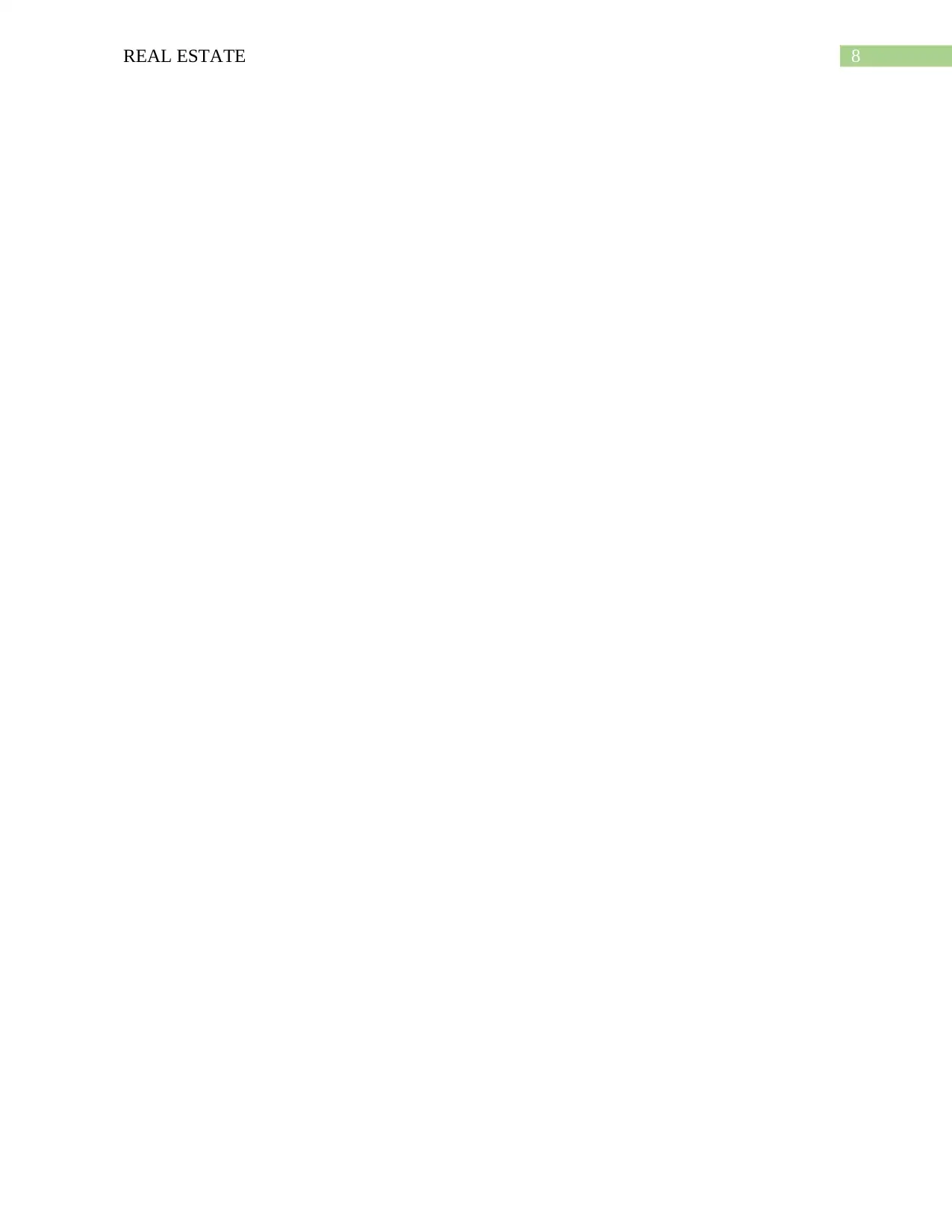
8REAL ESTATE
⊘ This is a preview!⊘
Do you want full access?
Subscribe today to unlock all pages.

Trusted by 1+ million students worldwide
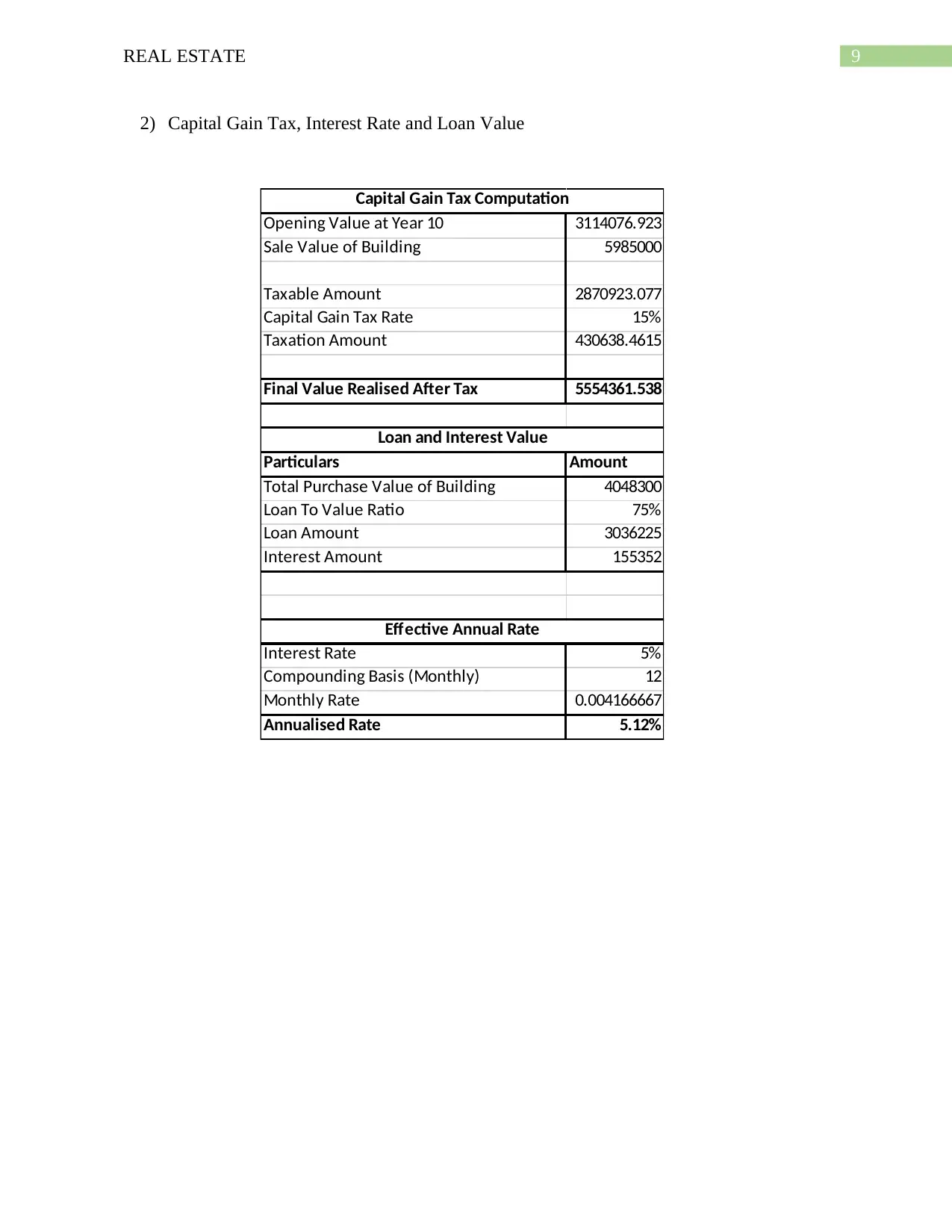
9REAL ESTATE
2) Capital Gain Tax, Interest Rate and Loan Value
Opening Value at Year 10 3114076.923
Sale Value of Building 5985000
Taxable Amount 2870923.077
Capital Gain Tax Rate 15%
Taxation Amount 430638.4615
Final Value Realised After Tax 5554361.538
Particulars Amount
Total Purchase Value of Building 4048300
Loan To Value Ratio 75%
Loan Amount 3036225
Interest Amount 155352
Interest Rate 5%
Compounding Basis (Monthly) 12
Monthly Rate 0.004166667
Annualised Rate 5.12%
Capital Gain Tax Computation
Loan and Interest Value
Effective Annual Rate
2) Capital Gain Tax, Interest Rate and Loan Value
Opening Value at Year 10 3114076.923
Sale Value of Building 5985000
Taxable Amount 2870923.077
Capital Gain Tax Rate 15%
Taxation Amount 430638.4615
Final Value Realised After Tax 5554361.538
Particulars Amount
Total Purchase Value of Building 4048300
Loan To Value Ratio 75%
Loan Amount 3036225
Interest Amount 155352
Interest Rate 5%
Compounding Basis (Monthly) 12
Monthly Rate 0.004166667
Annualised Rate 5.12%
Capital Gain Tax Computation
Loan and Interest Value
Effective Annual Rate
1 out of 10
Your All-in-One AI-Powered Toolkit for Academic Success.
+13062052269
info@desklib.com
Available 24*7 on WhatsApp / Email
![[object Object]](/_next/static/media/star-bottom.7253800d.svg)
Unlock your academic potential
Copyright © 2020–2025 A2Z Services. All Rights Reserved. Developed and managed by ZUCOL.
